And now, as promised and to confuse you further, here is the second half of my posting on venomous snakes. For a refresher on the first part, or just cause you can’t get enough of me, here’s a link to the first half. This posting will delve into the different types of venom that venomous species of snakes actually can possess. Oh, and by the way- a little further down is a picture of what can happen to someone’s arm if they get bitten by a venomous snake. It’s a little graphic, so heads up for the kiddos and those with weak stomachs! 🙂 Venom is not composed of a single substance, but is a toxic saliva consisting of a complex mixture of chemicals called enzymes. Almost all venoms are composed of approximately 90% proteins. The two main types are Hemotoxic, and Neurotoxic venoms.
Okay…
Slightly
Scary
Photo
Coming
Now!!
Beware!! 🙁
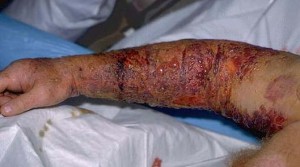
When it comes to venomous snakes, some (many are classed as Viperidae – including pit vipers -which can be copperheads, cottonmouths, most rattlesnakes and a number of exotic species) utilize Hemotoxic venom, which means that their venom effects the blood and organs, causing a breakdown or inflammation in the body. It causes the destruction of red blood cells, disrupts blood clotting and also causes organ degeneration and generalized tissue damage. Hemotoxic bites are the most painful as breathing hurts and tissues start to die. Another purpose of hemotoxic venom is aiding digestion, as the venom breaks down protein in the region of the bite, making prey easier to digest.
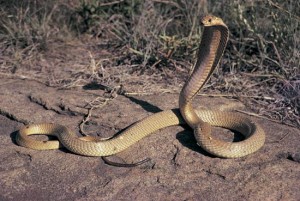
The other main type of venom is Neurotoxic (the snakes possessing this are usually Elapids – cobras, coral snakes, mambas, and others). Neurotoxic venom, as per the name indicates, affect the nervous system, leading to everything from seizures up to death. Neurotoxic bites are the most deadly and dangerous.
Although we have these two wonderful different categories, no snake fits completely in each. Many snakes incorporate both neurotoxic and hemotoxic venom in their bites so when telling them apart one goes by which type is more predominant. For instance Ophiophagous hannah(King Cobra) has predominantly neurotoxic venom while Crotalus adamanteus (Eastern diamondback rattlesnake) has predominantly hemotoxic venom. There are also two other, and much less predominant types of venom called cytotoxic and myotoxic. Cytotoxic is a venom which affects the cellular tissue usually restricted to the area of the bite but can spread. Myotoxic venom is most commonly found in the Lancehead vipers of South America and is known to cause muscular necrosis. It contains peptides that destroy the muscle fiber proteins and result in myonecrosis (muscle destruction).
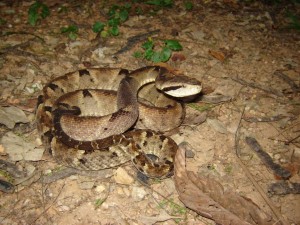
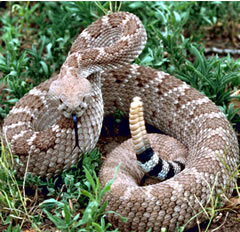
A final weird fact about venomous snakes is that most true venomous snakes don’t actually have to inject their venom into something if they don’t want to. Venom production takes time and is costly biologically speaking – taking up energy and time for the body to produce. So unless it’s to procure food, the snake does not want to expend it’s precious venom because then it may possibly be left defenseless until it can produce more. So snakes can actually do what is called a “dry bite” and bite something as a bluff to be left alone, but not inject any toxin at all. Half of all rattlesnake bites are dry. This is why many snakes have so many warning strategies. From warning colors, to hoods, to rattles, venomous snakes do everything in their power to avoid biting the enemy.
So now that you have a better understanding of venomous snakes, always remember that it’s never a good idea to muck with one. If you see one in the wild, give it a wide berth and keep well away. Believe it or not, the great majority of venomous snakebites are gotten when someone is messing with a snake who only wants to be left alone. Over 60% of them involve alcohol too by the way. See? Booze makes us smarter AND better looking! (Note, sarcasm…) 🙂
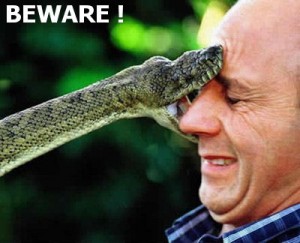
Venomous snakes only use their weapon to eat and as a last resort defense. Always do your best to respect them and leave them be. They are an important part of our environment, eating huge numbers of rodents each year. We leave them alone, and they’ll do the same for us.
Nice job, Mikey! Have you ever been bitten by a snake? What kind?
Karyn
PS- are you the one on the left or right of your profile picture? 🙂
Thanks for this overview, and also the extra info on spitting cobras in the comments! I personally don’t need any extra incentives to stay away from snakes, but it is very interesting information!
Hiya Karyn!
Sure I’ve been bitten by a snake before- you can’t work with them for years without a little nip here or there. Fortunately nothing venomous has ever tagged me -I’m VERY incredibly careful of course whenever I handle those guys! But when it comes to non-venomous, I’ve been bitten by a few different species. Rat snakes, Racers, water snakes and at least one very gripey African Rock Python 🙂
As for my picture – I’d say I’m the better looking one, but Gus might have me on that one- so I’m going with the fact that I have less facial hair (even without shaving that day!).
do it hurt
!!!!!!!!!!!!!!!!!!!!!!!!!!!!!!!!!!!! it sooo skiny!
if you have just been baet by a snake what can you do to stay alive
Remain calm and seek medical attention quickly if a venomous snake bites you.
I have never seen anything dangerous than this so I really feel sori for this poor guy hope u get well soon.
Snakes r incredible especially poisonous ones but r also very dangerous so stay safe pliz.